At Nextpoint we talk to thousands of attorneys with all types and sizes of cases. It’s fair to say every case is unique, attorneys’ clients are all difficult in their own way, and that traditional litigation technology fails legal teams for different reasons.
That said, law firms tend to come to us when they are facing a severe technology pain point or an explosion in their costs. As I see it, there are some very common circumstances that are leading them to the breaking point:
1. Limited data storage space or outdated IT infrastructure.
It’s always eye-opening to chat with a lawyer who knows the actual price of a server. This is something no lawyer should need to know. Lawyers should be counseling clients, not wrestling with a budget to allow for a new file server. If the poor state of technology is forcing lawyers to become IT experts and spend thousands on hardware, something is definitely wrong.
2. Limited access to client/case data outside of the office.
Remember the last time you were in an airport logging into the free Boingo wifi? Yeah, it’s lousy. The problem gets even worse when your litigation technology still requires an ancient, clunky Virtual Private Network (VPN) to access. Modern litigation technology is mobile enabled and secure so that you can work wherever, whenever you need. That saves time and money.
3. Complexity and inefficiencies of current eDiscovery tools.
If you visited Google.com over a decade ago, you would have found pretty much the same basic search functionality you see today. Amazingly, Google still offers the same mind-blowing search speeds today despite the explosion of content on the Internet. That’s because Google knows it’s core functionality and does it exceedingly well. Sure, they have added a lot of new features under the hood, but the search function is still the best available.
Why shouldn’t eDiscovery software be the same? Why does every release pile on more features that no one knows how to use? (see CAR/TAR/Clustering) Great software adds power under the hood, while keeping the user interface simple and straightforward.
4. Bouncing from one tool to another.
In a mature industry, there should be a handful of great products that everyone understands and knows how to use. eDiscovery is still a fractured market with new one-trick-pony tools entering the game all the time. How many tools does it take you to get the job done? Four?…Five? Higher still? Hello, budget-death-spiral.
Firms need a powerful database that handles large volumes of data and review tools that can search and display any type of document, stamp them appropriately, and produce the resulting output to opposing counsel. You shouldn’t need a “Frankenstein’s Monster” of a half-dozen software tools kludged together to get that done.
5. Don’t rely on your guy.
Remember Kramer’s friend Bob Sacamano on Seinfeld? He was Kramer’s “guy,” the friend who could get goods and services no one else could.
Often at firms, there is a person who uses every tool in the toolbox and is proficient at solving nearly every data/technology challenge the law firm encounters. On the other hand is the person who has no idea about the firm’s internal capabilities who always calls “his guy” when a new project comes across his desk.
This is a problem. Someone within the firm should take initiative to identify the resources that the firm has and properly engage the right people to manage them. Law firms should not have to rely on one person to make the technology work.
Poor technology can hinder law firms for many reasons. We have been prodding law firms to ditch creaky old databases and move towards simple, powerful, cloud based technology for almost a decade. It is simply more efficient from a cost and time perspective.
Yes, litigation software needs to be powerful enough to meet the demands of modern litigation. But it should be simple to use and manage so that lawyers need not waste time thinking about new hardware purchases, cobbling together disparate tools, or getting in touch with the one person in the office who knows how to find stuff in the old Summation or Concordance databases.
If you’re feeling those pain points, give us a call. Even if I haven’t heard your particular story before, we’re sure we can help.







